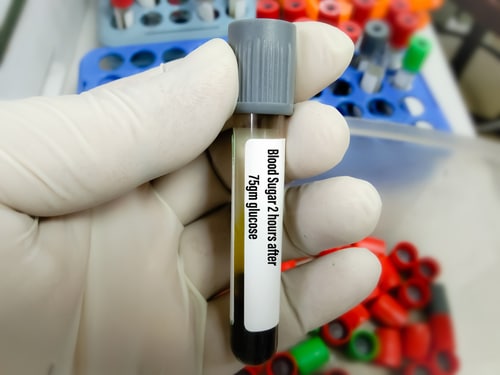Diabetes in Australia has become a significant problem, with 1 in 20 people living with type 1, 2 or gestational diabetes. It not only impacts blood sugar levels but can have far-reaching consequences on mobility and overall quality of life.
In this comprehensive guide, we delve into Australians’ most asked questions about this condition. We look at its prevalence, types, diagnosis, why it’s increasing in our country and more.
In this article
- How many people in Australia have diabetes?
- Is diabetes a disability?
- What is type 2 diabetes?
- What is type 1 diabetes?
- What is gestational diabetes?
- How to test for diabetes
- Why is diabetes increasing in Australia?
- How much does diabetes cost Australia?
- Why is diabetes a health priority in Australia?
- How do you treat diabetes?
- Insure your independence

How many people in Australia have diabetes?
According to the Australian Institute of Health and Welfare, there are about 1.3 million people in Australia who have diabetes. This is about 1 in 20 people. However, the Institute notes that these rates are likely to underestimate the true prevalence of diabetes in the Australian population.
Why is this? Let’s explore.
There are plenty more people with diabetes than we know
Firstly, in Australia research has found that a lot of people have diabetes without even realising. In a study in 1999-2000, for example, it turned out that half of those with diabetes didn’t have an official diagnosis. And in a survey in 2011-12, around 20% of adults had diabetes they didn’t know about before the survey.
Secondly, that 1.3 million people number is based on the Australasian Paediatric Endocrine Group (APEG) state-based registers and people who join the National Diabetes Services Scheme (NDSS).
Not everyone with diabetes joins the NDSS. It’s a voluntary program, and it’s estimated to include about 80-90% of people who’ve been diagnosed with diabetes. People with type 2 diabetes are more likely to join if they need diabetes supplies to manage their condition at home or if they use insulin.
Finally, the NDSS doesn’t have as many Indigenous Australians in it as compared to the overall population. This is important when we’re trying to understand diabetes in Indigenous communities.
So, plenty of Australians are out there dealing with diabetes but haven’t yet been (or may never be) officially diagnosed by a doctor.
Is diabetes a disability?
Yes, it is. Even if a person is healthy and the diabetes is well-managed. According to the Commonwealth and State anti-discrimination laws, along with the Disability Discrimination Act of 1992 (Cth), diabetes falls under the category of a disability.
This condition is considered a hidden or invisible disability because it substantially limits the function of the endocrine system. Diabetes comes in various forms, each with its own unique characteristics. Let’s look into each.
What is type 2 diabetes?
Unlike type 1, type 2 diabetes is typically diagnosed in adulthood. It stems from insulin resistance, where the body’s cells fail to respond efficiently to insulin. Insulin is a hormone that helps control the sugar in our blood – it helps sugar get into our cells to give us energy.
When our cells aren’t responding well to insulin, initially the pancreas compensates by producing more of it. However, over time it struggles to maintain normal blood sugar levels.
What causes type 2 diabetes?
As mentioned, type 2 diabetes happens when our bodies can’t use sugar (or glucose) properly. It’s kind of like a traffic jam with sugar in our blood. There are a few reasons why this happens:
Unhealthy eating
Eating too many sugary or fatty foods regularly can make our bodies resistant to insulin.
Lack of exercise
Not getting enough physical activity can also make our bodies less responsive to insulin. It’s like our cells get lazy and don’t want to let sugar in.
Genes
Sometimes, it can be in our genes. If other people in our family have diabetes, we might be more likely to get it too.
Being overweight
Carrying too much weight, especially around our belly, can increase the chances of getting type 2 diabetes.
Age
As we get older, our risk of type 2 diabetes goes up.
Not enough sleep
Not getting proper sleep can also affect how our bodies handle sugar.

What is type 1 diabetes?
Type 1 diabetes, often diagnosed in childhood or adolescence, is an autoimmune condition. The body’s immune system erroneously targets and destroys the insulin-producing cells in the pancreas.
This target-and-destroy situation results in a deficiency of insulin, necessitating regular insulin injections or the use of an insulin pump.
How many people have type 1 diabetes in Australia?
There are around 140,000 Australians with type 1 diabetes. It’s less common than type 2 diabetes, which affects a lot more people.
What is gestational diabetes?
This kind of diabetes happens during pregnancy. When a woman is pregnant, her body sometimes can’t make enough insulin. This can lead to high levels of sugar in the blood, something that’s important to manage because it can affect both the mother and the baby.
Usually, it goes away after the baby is born, but it’s essential to monitor and control it during pregnancy to keep both mum and baby healthy.
How common is gestational diabetes in Australia?
Gestational diabetes is the most common medical complication of pregnancy in Australia. About 1 in 6 pregnant women in Australia will develop it. This means that about 17.9% of pregnant women who give birth in a hospital in Australia will be diagnosed with gestational diabetes.

How to test for diabetes
In Australia, diabetes is diagnosed through a simple blood test. Here’s how it works:
Blood sugar test
A healthcare provider will ask you to take a blood test. You might need to fast (not eat) for a few hours before the test. They’ll check your blood sugar levels to see if they’re too high.
HbA1c test
Another way to diagnose diabetes is by doing an HbA1c test. This test measures your average blood sugar levels over the past few months. It gives a good idea of how well your body has been handling sugar.
Oral glucose tolerance test
Sometimes, if the first tests aren’t clear, the doctor might ask you to drink a sugary solution and then check your blood sugar levels at different times to see how your body processes sugar.
If the results of these tests show your blood sugar levels are consistently too high, you may be diagnosed with diabetes. It’s important to remember that if you’re concerned about diabetes, it’s best to talk to a healthcare professional who can guide you through the testing process and provide the right diagnosis and advice.

Why is diabetes increasing in Australia?
Diabetes is on the rise in Australia for a few reasons, including:
An increasingly unhealthy lifestyle
More and more people are eating too much unhealthy food and not getting enough exercise. As we’ve explained earlier, this can increase the risk of type 2 diabetes. According to the OECD, Australia is among a number of its member countries where the prevalence of overweight and obesity has increased in recent decades.
People are getting older
As people in Australia live longer, the risk of diabetes goes up because it’s more common in older folks.
Urbanisation
People are moving to cities where it’s easier to get less healthy foods and less physical activity.
So, it’s a mix of lifestyle and an ageing population, as well as genetics, that’s contributing to the increase in diabetes in Australia. It’s important to focus on prevention and better management to help reverse this trend.
How much does diabetes cost Australia?
Diabetes costs Australia a lot of money. It produces a big bill that the country has to pay, for things like medical care, medicines, and lost productivity.
In fact, it’s one of the most expensive health conditions in Australia.
Diabetes costs can include doctor visits, hospital stays, medications, and all the equipment needed to manage diabetes, like glucose meters and insulin. Plus, when people can’t work because of diabetes, it affects the country’s economy.
So, it’s not just about the money; it’s also about the impact it has on people’s lives and the country as a whole. That’s why it’s essential to work on preventing and managing diabetes to reduce these costs and improve the health of Australians.
Why is diabetes a health priority in Australia?
Diabetes is a big health priority in Australia because it affects a lot of people and can cause serious health problems. Lots of Australians have diabetes, and the numbers are growing. This means that many families and communities are dealing with it.
Diabetes can lead to other health issues like heart problems, kidney disease, and problems with your eyes. So, it’s not just about diabetes itself; it’s about the other problems it can cause. Taking care of diabetes and its complications costs a ton of money. This money could be spent on other important things if we can find ways to prevent and manage this condition better.
Diabetes can change how people live. They might need to watch what they eat, how they exercise, carefully schedule taking medicine, and visit the doctor often. This can affect their quality of life.
The good news is that many cases of type 2 diabetes can be prevented or delayed by making healthy lifestyle choices. So, by focusing on prevention and better management, we can improve the health of Australians and save money in the long run.
That’s why Australia is working hard to make diabetes a health priority – to help people stay healthy and reduce the impact of diabetes on individuals and the country as a whole.
How do you treat diabetes?
Diabetes can’t be cured, but you can manage your diabetes through medication and healthy lifestyle changes. This includes:
Eating a healthy diet
Make sure your nutritional intake includes plenty of fruits, vegetables, and whole grains. On the flipside you should be limiting processed foods, sugary drinks, and saturated and unhealthy fats.
Exercising regularly
Aim for at least 30 minutes of moderate intensity exercise most days of the week. Do you have physical challenges that restrict your movement? Read our ‘Exercising with Limited Mobility‘ article.
Maintaining a healthy weight
Losing even a small amount of weight can help improve your blood sugar control.

Medication
If lifestyle changes are not enough to manage your diabetes, you may need to take medication. There are many different types of diabetes medications available and your doctor will work with you to find the best one for you.
Some common types of diabetes medications include:
Insulin
As you’d be well aware having read this far, this is a hormone that helps your body’s cells use glucose for energy. Those with type 1 diabetes take insulin because their bodies don’t produce enough. Some people with type 2 diabetes also need to take insulin.
Oral diabetes medications
These work in different ways to lower your blood sugar levels. They may be prescribed alone or in combination with insulin.
Other medications
Other medications, such as blood pressure medications and cholesterol medications, may also be used to help manage diabetes and reduce the risk of complications.

Read more about diabetes
We have a couple more articles in our extensive blog that focus on diabetes. Click through to them here:
- Diabetes Related Amputation: Causes and Prevention
- Driving with Diabetes – Always Tell Your Car Insurer
Insure your independence
Diabetes can affect your mobility in a number of ways – from leading to neuropathy, which can impair sensation and muscle function, to causing poor blood circulation that leads to muscle weakness. Diabetes can also affect the musculoskeletal system, resulting in conditions like frozen shoulder or limited joint mobility. This is why mobility aids are so important for those living with diabetes.
Wheelchairs, mobility scooters and converted cars are essential to our mobility and quality of life. If these devices get run down, stolen, or damaged, it can be too expensive to replace or repair.
That’s why so important to have wheelchair insurance, mobility scooter insurance and car insurance. As a specialist independence and mobility insurance provider, Blue Badge Insurance offers these tailored policies. We also give up to 25% discount on premiums for disability permit parking holder car insurance.
Contact us at Blue Badge to find out more about getting your insurance or simply get a quote below.








